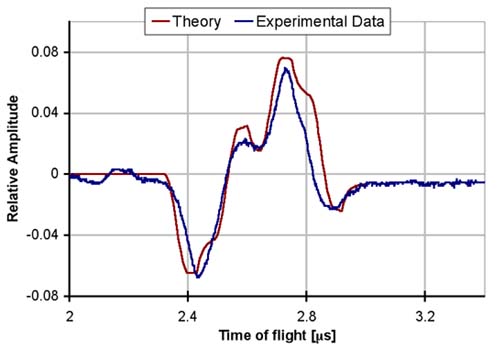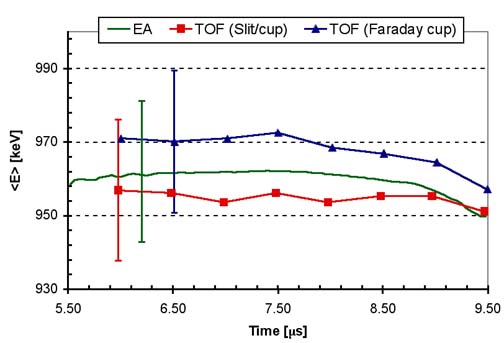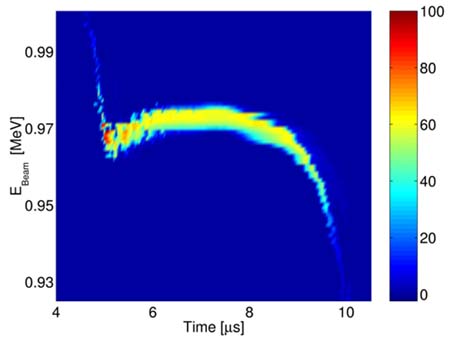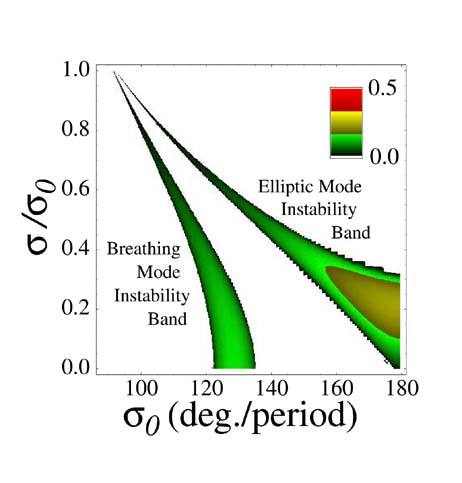The High Current Experiment (HCX) at LBNL is primarily designed to
study the transport of high current beams at the low energy end of a Heavy
Ion Fusion (HIF) driver. Two new diagnostics, an electrostatic Energy Analyzer
(EA) and a Time of Flight pulser (TOF) were installed to more precisely
determine the beam energy and to make longitudinal phase-space measurements.
The EA, a 90° spectrometer with a radius of 46 cm, and a gap of 2.5
cm was operated up to ΔV = 110 kVor delta V= 110 kV. The relative accuracy is ± 0.2%,
allowing us to follow variations in the beam energy as a function of time
during the beam pulse. The EA calibration depends on the geometry
and fringe fields of the analyzer. By changing the beam energy by a known
absolute amount, we provide an independent calibration. The beam passed through
a 28%-transparent hole-plate, and the gas cloud created at the hole-plate
stripped singly-charged K+ beam ions to doubly-charged K2+.
The absolute calibration was determined by varying the electric potential
at the plate, and thus the energy of the K2+
ions entering the EA.
TOF measurements were made by inducing short-duration (0.3 μs FWHM),
small-amplitude (~10 keV) energy perturbations in the matching se ction
using a specially designed fast pulser. These energy pulses were manifest
as current perturbations measured ~5 m downstream. Figure 1 shows a close-up
of the beam current waveform measured downstream along with a theoretical
calculation of the expected perturbation based on a 1-D cold-fluid model.
Comparing the measured and expected delay time of the perturbation determines
the absolute energy of the beam.
Both the TOF an EA diagnostics determine the absolute beam energy to
±2%, with both measurements agreeing within these uncertainties (Figure
2). The precise determination of the energy is essential for agreement
between simulations and experimental data.

Figure 3 shows the longitudinal energy distribution obtained with
the EA. The high-energy head and low-energy tail are understood to be from
the beam longitudinal space charge, which accelerates particles at the
front end of the bunch and decelerates particles at the rear of the
pulse. These data also show that in the middle of the pulse, the mean beam
energy is constant to within 0.5% for 3.1 ms.
Figure 1 – Cold fluid model vs TOF
perturbation on the beam current
waveform. Perturbation applied @ t = 0.
This information (particularly the head and tail energy variations with
respect to the core of the beam pulse) will be used to help complete the
design of a bunch end control module to be installed next year

in between the matching section and the periodic transport
lattice; a first step towards conducting more longitudinal physics experiments.
- L. Prost, F. Bieniosek, A. Faltens, P. Seidl, W.
Waldron
Figure 2 – TOF and EA measurements
comparison.

The error bars represent the systematic
error (± 2%).
Figure
3 – Longitudinal Energy
Distribution measured with the
electrostatic energy analyzer.
Study
of mismatch oscillations in beam envelope
Mismatch oscillations, in the envelope
of beam particles, play a role in transport limits by generating halo. This
induces beam loss, resulting in gas desorption and secondary electron production,
so understanding mismatch oscillations are important in the transport
of intense ion beams. We performed an extensive analytical and numerical
study on the transverse envelope oscillations of intense ion beams in continuous
focusing, periodic solenoidal, and periodic quadrupole transport channels.
This study significantly extends earlier work by Struckmeier and Reiser [Part.
Accel. 14, 227 (1984)] and is being submitted for publication. We map regions
of parametric instability, find new classes of envelope instabilities, explore
parametric sensitivities, describe launching conditions for pure normal
mode oscillations, and calculate analytically accessible limits. We also
analyze driving sources of mismatch oscillations resulting from focusing
errors, particle loss, and beam emittance growth. The figure shows bands
of parametric instability for breathing and elliptical envelope distortions
for a periodic solenoidal focusing lattice with solenoids filling
75% of the lattice. If higher order instabilities can
also be suppressed, broad parameter regions with σ0 >90° or sigma0 >90 degrees outside
of the envelope instability bands can be exploited to allow transport of
higher current density beams.

- Steven M. Lund and Boris Bukh
Figure 1 – Contours of the log of
the growth in envelope oscillation
amplitude per lattice period for
periodic solenoid focusing as a
function of the single particle phase
advance σ0 or Sigma0 and the space-charge
depressionσ/σ0 or Sigma/Sigma0.
.


